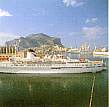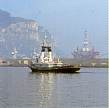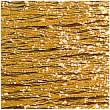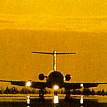|
|
LEG
|
NAUTICAL
MILES
|
BUNKERING
|
WAYPOINT
|
SUNSHINE
DAYS
|
|
-
|
-
|
-
|
-
|
-
|
|
|
-
|
-
|
-
|
-
|
|
-
|
-
|
FILL
UP
|
Gibraltar
|
00.00
|
|
1
|
729
|
-
|
Tenerife,
Canary Islands
|
1.90
|
|
2
|
3,154
|
-
|
Trinidad,
Port of Spain
|
8.21
|
|
3
|
1,182
|
1
|
Panama
City
|
3.00
|
|
4
|
970
|
-
|
Galapagos
|
2.45
|
|
5
|
3,640
|
-
|
Tahiti
|
9.48
|
|
6
|
1,423
|
-
|
Tonga,
Nukualofa
|
3.71
|
|
7
|
410
|
-
|
Fiji,
Suva
|
1.07
|
|
8
|
1,886
|
1
|
Port
Moresby PNG
|
4.91
|
|
9
|
340
|
-
|
Thursday
Island, Cape York
|
0.88
|
|
10
|
724
|
-
|
Darwin
|
1.89
|
|
11
|
1,572
|
-
|
Jakarta,
Indonesia
|
4.09
|
|
12
|
1,881
|
-
|
Colombo,
Sri Lanka
|
4.90
|
|
13
|
2,109
|
1
|
Aden,
Yemen
|
5.49
|
|
14
|
698
|
-
|
Jeddah,
Saudi Arabia
|
1.82
|
|
15
|
670
|
-
|
Port
Said, Egypt
|
1.75
|
|
16
|
1,111
|
-
|
Palermo,
Sicily
|
2.89
|
|
17
|
170
|
-
|
Naples,
Italy
|
0.44
|
|
18
|
940
|
|
Gibraltar
|
2.45
|
|
-
|
-
|
-
|
-
|
-
|
|
-
|
23,609
|
-
|
RUNTIME
DAYS @ 12.5kts
|
78.70
|
|
-
|
-
|
(ADD
3 DAYS)
|
RUNTIME
DAYS @ 13kts
|
75.67
|
|
-
|
-
|
-
|
-
|
-
|
|
-
|
-
|
(ADD
4 DAYS)
|
14
KNOTS AVE INC
|
70.26
|
|
-
|
-
|
-
|
AT
15 KNOTS AVE
|
65.58
|
|
-
|
-
|
-
|
AT
16 KNOTS AVE
|
61.48
|
Once regarded as Europe's grandest, most beautiful city, Palermo is
still quite impressive. The Four Corners of Palermo, where each
17th-century Spanish Baroque facade is adorned with a statue, is one
of the city's most memorable sights. The Fontana Pretoria, often
called the Fountain of Shame because of its nude Florentine figures,
is also worth noting. Tour the famous Norman Cathedral and Capuchin
catacombs. A day trip to Monreale to see the famous 12th-century
cathedral is also recommended.
This is the biggest island in the Mediterranean, separated from the
Italian peninsula by the strait of Messina. It has important
mountain groups: Peloritani, Nebrodi, Madonie, Iblei. The coasts
offers a landscape of beauty almost everywhere; groups of smaller
islands are scattered round the coast (the Eolie or Lipari, Ustica,
the Egadi. the isle of Pantelleria and the Pelagie). The Etna,
rising in the center of a volcanic area of Sicily, is the highest
active volcano in Europe (3,323 mt). The isles of Stromboli and
Vulcano also are active volcanoes.
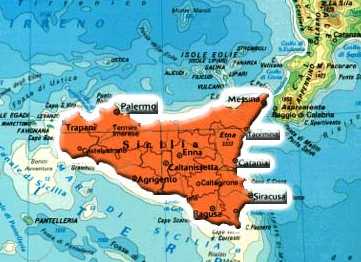
SICILY :
Provinces: Palermo,
Messina, Siracusa
PALERMO
HISTORY
Founded
during the last quarter of VII c. BC by Phoenician merchants,
Palermo only appeared in the history in 480 BC when the Carthaginians,
in war against the allied Greek towns, took refuge for few days in the
port of the Sicilian town before starting the siege of Himera. Sacked
by the Syracusan Hermocrates in 409 BC, Palermo then established a
strong alliance with Carthage, which was very useful for the African
colony during the war against Dionysius the Elder (beginning of IV c.
BC), Agathocles (end of IV c. BC) and Pirrus (282-278 BC).
During the First Punic War, which opposed Carthage to Rome with the
aim of conquering the whole Sicily, the strategic position of Palermo
in the center of the conflict forced the Roman to concentrate most of
their strengths upon the Punic town, which felt in their hands in 254
BC.
If
our information about the town of Palermo and the other Punic colonies
in general are very poor, it totally depends by the Greek and Latin
literature, which were very hostile towards the Punic world. In
fact, after the destruction of Carthage of 146 BC, The Roman Senate
gave all the libraries of the town to its principal allied in Africa.
Today they have totally disappeared, depriving us of direct and
detailed information about the several Punic colonies.
PALERMO
TODAY
Historical Palermo sits compactly around one central crossroads, the
Quattro Canti, which is at the core of four distinct quarters. The
Albergheria and the Capo quarter, the latter beyond the cathedral,
lie roughly west of Via Maqueda; the Vucciria and old harbour of La
Cala and the La Kalsa, lie to the east, closest to the water. In
these areas you'll find virtually all the surviving ancient
monuments and buildings of the city: the hybrid Norman-Arab-Baroque
Cattedrale-S.Maria Assunta and nearby Palazzo dei Normanni (Royal
Palace), with its superb, mosaic-decorated chapel, the Cappella
Palatina; the glorious Norman churches of La Martorana and San
Giovanni degli Eremeti; the Baroque opulence of San Giuseppe dei
Teatini. Located in the center of Palermo, near Via Libertà.and
Piazza Croci, Villa Trabia is one of the few aristocratic homes open
to the public.
This estate, which is now owned by the City of Palermo, houses civic
offices and a public library. The palace is set in a beautiful
wooded park open to the public most days. Built for the Prince of
Trabia (Lanza family) in the eighteenth century, Villa Trabia
provides a glimpse of the lifestyle of the Palermitan aristocracy of
that era. Just outside Palermo you may visit the La Favorita and La
Zisa villas and the Capuchin Convent, with its catacombs.
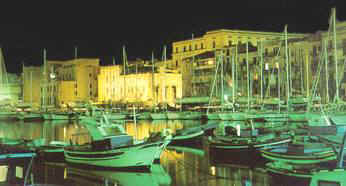
Punic
Harbour of Palermo
ORIGINS
and CULTURE
Palermo’s
origins date back to the period between the 8th
and the 6th
century B.C., when the Phoenicians colonized the area that was
previously inhabited by Sicans, Cretans and the Elimi.
After being contested for a long period between Rome and Carthage
during the Punic wars, the city of Paleopolis was
placed under Roman rule (254 B.C.).
After several attacks by various barbaric populations, the city then
became a part of the Byzantine Empire, which governed it for
about three centuries, until 831.
The Arabs took over from the Byzantines and under their rule,
Palermo enjoyed a period of splendor and prosperity. Art and
economics were developed immensely, the first thanks to the
influence of Arab culture and the latter through intense trading
with the main Italian ports. Palermo increased its prestige by
building mosques, luxurious palaces and wonderful gardens.
The Arabs ruled until 1072 when the Normans succeeded in
gaining possession of the city after a long siege, and thus began a
new era during which the population spread out throughout the
island. Under Norman rule, Palermo was allowed a fair amount of
autonomy, while in the city, palaces and monuments that were the
symbols of this crossroads of culture, such as the Cappella
Palatina (Palatine Chapel) and the Cathedral - Duomo in
Monreale were built.
Palermo passed into the hands of the Swabians and Frederick
II after the Normans: in this period, art and literature were
developed even further, culminating in the setting up of the
Sicilian School of Poets.
Under the French king, Charles of Anjou, Palermo lost a great
deal of its autonomy, but the people rebelled, and started up the
war of the Sicilian Vespers (1282) that continued for twenty
years and which was intended to throw out the French from the
island.
Spanish dominion (1400 - 1700) saw the beginning of a
peaceful period for this much contested city that had been in the
hands of various countries over the centuries. Palermo was once
again the capital and the town’s buildings and monuments were
renewed. Various religious orders, which were increasingly powerful,
set up a large number of churches and convents. This was a period of
pomp and opulence for the clergy and the aristocracy, but was also
one of poverty and pestilence for the people, whose rebellions were
often put down without the sparing of blood.
After a brief interval under the Sabaudo family Dynasty (1713 -
1718) and then under the Austrians (1718 - 1735), Palermo and Sicily
were once again returned to the Spanish, and became the Autonomous
State of the Kingdom of Naples. When the Bourbon family decreed that the autonomy granted should be
repealed, the whole of Sicily rose up (1820 and 1848) and finally in
1860, when Garibaldi and the thousand landed at Marsala,
Palermo won its freedom, and then annexed itself to the Kingdom
of Italy in 1870.
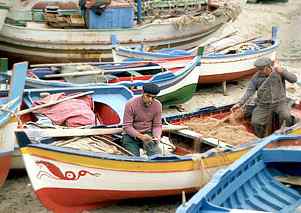
Palermo
fishermen
CATANIA
A splendid Baroque City at the slopes of the Etna, from the
eighteenth century on, Catania has been considered the second most
important city of Sicily. Subjected to the Etna Vulcan, this town
has been damaged by lava flows and earthquakes on several occasions.
The city has two Roman amphitheatres, one which was built on a
pre-existent Greek one and the other which is a completely Roman
structure.
Visit the Ursino Castle, built on the orders of Emperor Frederick II
von Hohenstaufen in the first half of the thirteenth century, and
now a museum open to the public. The oldest part of the Duomo
(Cathedral) dates back to 1092; it hosts the tombs of Frederick III
of Aragona, who ruled from 1296-1337, and the one of Constance, wife
of Frederick IV of Aragona. Most of Catania’s wide streets and
palazzi were built during the eighteenth century, a characteristic
is the gray, volcanic stone used in the buildings.
This was the
period in which noble families from across eastern Sicily, used to
build palazzo in Catania, beginning a subtle social and economical
rivalry with Palermo. The two most famous citizens are S.Agata, the
martyr patroness of the city and Vincenzo Bellini, the opera
composer. Stroll through Via dei Cruciferi and visit the churches of
S.Benedetto, S.Giuliano and S.Niccolò.
Il Porto di
Palermo
Informazioni di carattere generale
General information
Autorità
Portuale di Palermo
Via piano dell'ucciardone, 4
90139 Palermo
Tel : 0039 91 6277111 - Fax : 0039 91 6374291
|
Posizione
Position
|
Carte
nautiche
Charts
|
Clima
Climate
|
|
38°
08' N 13° 22' E
|
n.255
piano nautico del porto;
n.256 golfo di palermo
n. 255 Chartplan of the port
n.256 The Gulf of Palermo
|
Mite.
La temperatura media annuale
e' di circa 17 gradi.
Mild. The annual average temperature is
about 17 degrees centigrade.
|
THE
CONFIGURATION OF THE ANCIENT TOWN
The
actual configuration of Palermo is not representative of the ancient
one, which attributed it the name of "Panormos". In fact a
long sedimentary process made the two rivers which delimitated the
town disappear. They were the Papireto to the West and the Kemonia to
the East. The last one flew into the sea with an estuary, creating an
immence natural port sheltered from bad weather and attacks. The
Diodorus Siculos information, according to which 3000 Carthaginian
warships and merchantships refuged for three days in the port of
Palermo to repair the damages suffered during a crossing in the
Mediterranean Sea, shows us that this port could contain an enormous
number of ships, with the possibility of repairing them in a short
time.
Nowadays the touristic port of the Cala represents the only visible
testimony of the ancient estuary.
As concerns the limits of the town, they can be traced thanks to the
studies of the fortifications which started from the today's Via
Schioppettieri to reach the Norman Palace passing through the
Rua dei Formaggi and the Via dei Biscottari. From there
they continued towards the Porta Santa Agata alla Guilla, running
alongside the actual military area and continuing in the streets Celso
and Calderai. This area approximately corresponded to the "Cassaro",
upper part of the historical centre.
|
Densità
dell'acqua di mare
Sea water density
|
Ora
Time
|
Aereoporto
Airport
|
|
1025
|
Ora
media di Greenwich più un'ora
(da Ottobre a marzo);
Ora media di Grenwich più due ore
(da marzo a ottobre);
GMT plus one hour (from October
to March);
GMT plus two hours (from March
to October);
|
La
distanza dall'aereoporto di Punta
Raisi è di circa 25 Km. Il collegamento
è assicurato con servizi regolari di
pullman.
The Punta Raisi Airport is about 25 Kmtrs
.far from the port. It is served by regular
bus service.
|
SIRACUSA
Until Roman times, this was the most powerful and magnificent city
in all Sicily. Today, it is an impressive and intriguing sight, with
a mixture of late Baroque architecture - vivid yet damaged by the
passage of time, and the reconstruction of the city following the
terrible earthquake of 1693 - and ancient classical architecture. It
is situated in an exquisite landscape of sea, rocks and
Mediterranean vegetation. Siracusa may be divided in several areas.
The most ancient part of town is the island of Ortigia, linked to
the mainland by the Ponte Nuovo. Have a stroll and look at the Fonte
Aretusa, related to the myth of the goddess Diana’s nymph. Don’t
miss the beautiful Baroque Duomo with its ornate chapels, carved
Doric columns, frescoes and statues. The other Baroque buildings, on
the same square, include the striking Palazzo Beneventano del Bosco
whith a lovely courtyard, the Palazzo del Senato and the Church of
Santa Lucia alla Badia (S.Lucy is the patron saint of this town).
Visit the Linear Theatre and the churches of S. Maria delle Colonne,
S.Giovanni, S.Pietro, Palazzo Mergulese-Montalto. Palazzo Bellomo
hosts an Art gallery ( Entombment of St. Lucy by Caravaggio,
Annunciation by Antonello da Messina), and the imposing Maniace
Castle with its Swabian architecture don’t has to be missed. Via
della Maestranza is one of the oldest and interesting streets of
Ortigia, literally stuffed with Baroque buildings: look out for
Palazzo Interland Pizzuti, Palazzo Impellizzeri, Palazzo Bonanno,
Palazzo Romeo Bufardeci, S.Francesco all’Immacolata. We also
recommend a walk through Mastrarua, another old street, Via
Mirabella and Corso Matteotti, full of shops. Also interesting: the
Church of S.Spirito and the Belvedere S.Giacomo which offers a
spectacular view.
In the archaeological area on the mainland part of town, called
Parco Archeologico della Neapolis, you may visit the Ear of
Dionysius (situated in the Latomia del Paradiso, a garden with
orange and palm trees), the ancient Greek theatre, the Roman
amphitheatre and the Tomb of Archimedes. In the Regional
Archaeological Museum Paolo Orsi you may view many interesting finds
dating back to Sicilian prehistory.
In the areas of Tyche and Akradina: visit the Papyrus Museum, the
S.Giovanni Catacombs, the Crypt of S.Marciano, the Basilica of
S.Giovanni Evangelista and S.Lucia extra moenia. Also worth: a walk
to the Eurialo Castle, on the north side ot town.
A favourite excursion is a boat trip starting at the Fonte Ciane,
at about 8 km out of town; it will get you to the spot, where,
according to Ovid, the Rape of Proserpina took place.
Noto: Defined as “Stone garden", Noto was entirely built with
a soft stone that, owing to the effect of sun rays, has gradually
acquired a beautiful honey shade.
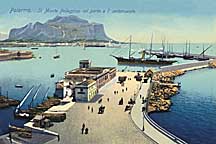
Palermo
painting
MESSINA
Two great earthquakes hit this city, in 1783 and 1908, and during
WWII it was heavily bombed.
Visit the Museo Regionale with Byzantine and Norman works as well as
works by Messina’s famous artists, Antonello da Messina and
Girolamo Aliprandi. Also interesting the Mannerist building - Monte
di Pietà and the church Santissima Annunziata dei Catalani. A short
way from the Duomo, this church was built in the 12th century during
the Norman rule and remodelled later on by the Catalans. The apse is
a fine specimen of the Norman composite style, that combines Roman,
Moorish and Byzantine features. The Duomo has been rebuilt in Norman
style, after the earthquake of 1908. From the inside you may access
the Treasury, which displays a fine collection of religious objects
and vestments, reliquaries, candlesticks, chalices and a fine
1600’s monstrance, containing a host.
The astronomical clock on the bell-tower to the left of the
cathedral has a mechanism dating from 1933.Don’t miss a look at it
on midday! It consists of several layers, each with a different
display endowed with a separate movement. At the bottom, a two-horse
chariot sets the day of the week; above, the central figure of Death
looks at the four ages of man that pass before him. At the third
stage, the Sanctuary of Montalto sets the scene for a group of
figures which, according to the time of year, represent the
Nativity, Epiphany, Resurrection and Pentecost. At the top, the
tableau enacts a scene relating to a local legend whereby the
Madonna delivers a letter to the ambassodors of Messina in which she
thanks and agrees to protect the inhabitants of the town who were
converted to Christianity by St. Paul the Apostle.
The female bell-strikers are the local heroines Dina and Clarenza,
during the period of resistance against the Angevins (1282).. The
southern side of the bell-tower shows a perpetual calendar, the
astronomical cycle marked by the signs of the zodiac, and the
different phases of the moon. When the clock strikes midday, all the
mechanical figures come to life. On the Piazza del Duomo you may
admire the Fontana di Orione with allegoric statues of four rivers.
For excursions in the area:
Ganzirri and Torre Faro, two characteristic,
pictoresque fishing villages full of life. Or the medieval hill
village of Savoca which boasts interesting churches like the
Convento dei Capuccini, the 15th century Chiesa di San Michele with
fine Gothic-Renaissance portals, and the Chiesa Madre. From Casalvecchio
you’ll have a panoramic view over the Ionian coastline and may
visit the Chiesa Madre, decorated with Taormina marble.
Tindari: Piazzale Belvedere, Greek theatre and Basilica at
the archaeological site.
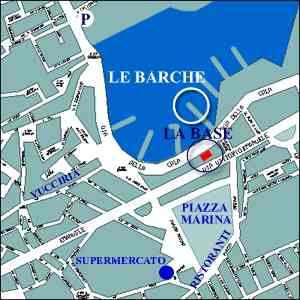
Palermo
marina
AEOLIAN ISLANDS
A volcanic archipelago on Sicily’s North-Eastern Tyrrhenian coast
with the islands of Lipari ( the largest one), Salina (a green
island with many wineyards), Filicudi, Alicudi, Stromboli (with an
active volcano), Panarea (a jet-set island) and Vulcano (famous for
its fango baths). The Greeks who colonized the islands around 580BC
named them after the god of the winds Aeolus. These beautiful spots
offer an enchanting landscape, great beaches with white sand,
castles, thermal resorts and medieval structures and are a main
tourist resort in Summer.
On Lipari the volcanic phenomenon can be observed in the
island's thermal springs (up to 600), in its solfataras and in its
12 volcanic systems converging towards the 602 metres of Monte
Chirica. This elevated and craggy island has spectacular beaches and
breathtaking ragged coasts.
Panarea - The main village, Contrada San Pietro, consists of
a group of white houses clustered along the eastern side of the
island. The built-up area is crowned with olive trees and protected
by huge walls. The other two villages north and south of San Pietro
are Dittella and Drauto.We recommend a boat tour to the nearby small
islands of Basiluzzo, Dattilo and Lisca Bianca, to the Scoglio
Bottaro (with its underwater "fumaroles").
Salina - More than 400 different types of plants grow here.
It is also the island with the highest peaks such as the three
volcanoes that originated e.g Monte Fossa delle Felci (962 m), which
is partially covered by one of the most beautiful strawberry tree
woods of the entire Mediterranean.
Vulcano - famous for the baths in the warm waters of its
submarine springs. This 21 km2, 500 metre high (Monte Aria) isle is
the Aeolian island closest to the Sicilian coast. Its name is a
clear description of its geography: a land of lava and fumarole,
yellow sulphur rocks and black sands all worth a visit.
Stromboli - This 924 metre high lava mountain (Serra Vancori)
which drops abruptly down to 2000 metres below sea-level is Europe's
biggest active volcano after Etna. During the night, the glittering
"sciara" of fire (the red-hot flow descending towards the
sea) can be seen from the boats and from Panarea. During the day,
the smoke of the peak joins the steam raising up from the water that
cools down the red-hot lava detritus which have plunged into the
water after sliding down the slope of the coast. The white houses of
the little village create a unique contrast with the black lava
background dotted with dark-green bushes.
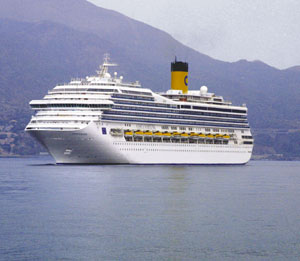
Italian
island cruise ship
LINKS
:
Daniel
Villiers
Europe
Europe
Travel Stories
Italy
Italy
Travel Stories
Palermo
Palermo
Travel Stories
Sicily
Sicily
Travel Stories
Western
Europe
Western
Europe Travel Stories
|
Adelaide
Aden
- Yemen
Afghanistan
Africa
Alaska
Albania
Algeria
Amazon
Rainforest
Amsterdam
Antarctic
- Scott
Arctic
North Pole
Argentina
Asia
Athens
Atlantis
- Plato's Lost City
Australia
Austria
Aztecs
- Mexico
Baghdad
Bahamas
Bahrain
Bangladesh
Barbados
Beachy
Head, England
Belgium
Benin
Berlin
Bermuda
Black
Rock Desert
Bohemia
Bolivia Bonneville
Utah History
Bonneville,
Utah, USA
Brazil
Brighton
- West Pier
British
Columbia
Buckingham
Palace
Bulgaria
Burkina
Faso
Burma
California
Canada
Canary
Islands
Cape
Horn
Cape
Verde
Cape
York - Au
Caribbean
Cayman
Islands
Central
Africa
Chichester
Harbour
Chile
China
Columbo
- Sri Lanka
Columbia
Corfu
Cowes,
Isle of Wight
Croatia
Crooked
Island, Bahamas
Cuba
Cyprus
Czechoslovakia
Darwin
- Australia
Daytona
Beach
Denmark
Eastbounre
Pier, England
Earthquakes
Ecuador
Egypt
Eindhoven Estonia
Equator
Europe
Falkland
Islands
Falmouth,
Cornwall
Fiji
Finland
Florida
France
Galapagos
Islands
Geography
Links
Geography
Mountains
Geography
Records
Geography
Resources
Geography
Statistics
|
Germany
Ghana
Gibraltar
- Links
Greece
Greenland
Guinea
Guinea
Bissau
Hawaii
Holland
the Nertherlands
Hollywood,
California, LA
Hong
Kong
Hungary
Hurricanes
Iceland
India
Indonesia
Links
Iran
Iraq
Ireland
Isle
of Man
Isle
of Wight
- The
Needles
Israel
Italy
Ivory
Coast
Jakarta
- Java
Jamaica
Japan
Johannesburg
Jordan
Kent,
England
Kenya
Korea
South Republic
Korea
North
Kuwait
Kyoto
Lanzarote,
Gran Canaria
Las
Vegas
Lebanon
Liberia
Libya
Liechtenstein
Life
on Earth
Lithuania
London
- Big
Ben
London
Eye
London
Houses
Parliament
London
- Buckingham
Palace
London
- Old
Bailey
London
- Overview
London
- The City
London
- Tower Bridge
London
- Trafalgar
Square
Luxembourg
Madame
Tussauds
Malaysia
Mali
Malta
Marshal
Islands
Mauritania
Maya
Empire -
Central America
Melbourne,
Australia
Middle
East
Mexico
Monaco
Morocco
Mountains
Mumbai
Naples-
Italy
National
Geographic
Nepal
New
York
New
Zealand
Niger
Nigeria
North
Africa
Norway
Nova
Scotia
Oceans
and Seas
Oman
Pakistan
Palermo
- Sicily
Palestine
Palma
- Malorca
|
Panama
Canal - Links
Paris
Pendine
Sands
Peru
Philippines
Pisa,
Leaning Tower
Planet
Earth
Poland
Port
Moresby - PNG
Port
Said - Egypt
Portugal
Puerto
Rico
Qatar
Quebec
Rio
de Janeiro
Romania
Rome
Russia
Salt
Lake City
Samoa
Saudi
Arabia
Scandanavia
Scotland
Senegal
Siera
Leone
Singapore
Solomon
Islands
Somalia
South
Africa
South
America
Southampton
Spain
- Espana
Sri
Lanka - Links
Stonehenge
Sudan
Suez
Canal
Sundancer
Holiday Resort
Sussex,
England Index
Sweden
Switzerland
Sydney,
Australia
Syria
Tahiti
- Polynesia
- Links
Tahitian
- Men & Women Customs
Taiwan
Thailand
The
Gambia
Togo
Tokyo,
Japan
Tonga
- Polynesia
Toronto
Trinidad
- Lesser Antilles
Trinidad
and Tobago
Tsunami
Tunbridge
Wells, England
Tunisia
Turkey
Tuvalu
Islands
UAE
- United Arab Emirates
UK
Statistics
Ukraine
United
Kingdom
United
Kingdom -
Gov
USA
Uruguay
Vanuatu
Islands
Vatican
City
Venezuela
Venice
Vienna
Vietnam
Volcanoes
Volendam
Wales
Washington
D.C.
WAYN
Where Are You Now
Wealden
iron industry
Wendover
West
Africa
World
Peace Supporters
Yemen
Yugoslavia
Zurich
|

Solar
Cola drinkers care about planet
earth
..
Thirst for Life

(330ml
Planet Earth can)
|


